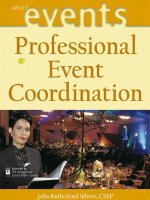ebook phương pháp phối hợp kênh truyền thông chuyên nghiệp special events coordinator
Bạn đang xem bản rút gọn của tài liệu. Xem và tải ngay bản đầy đủ của tài liệu tại đây (4.24 MB, 497 trang )
Professional
Event
Coordination
The Wiley Event Management Series
SERIES EDITOR: DR. JOE GOLDBLATT, CSEP
Special Events: Twenty-First Century Global Event Management, Third Edition
by Dr. Joe Goldblatt, CSEP
The International Dictionary of Event Management, Second Edition
by Dr. Joe Goldblatt, CSEP, and Kathleen S. Nelson, CSEP
Corporate Event Project Management
by William O’Toole and Phyllis Mikolaitis, CSEP
Event Marketing: How to Successfully Promote Events,
Festivals, Conventions, and Expositions
by Leonard H. Hoyle, CAE, CMP
Event Risk Management and Safety
by Peter E. Tarlow, Ph.D.
Event Sponsorship
by Bruce E. Skinner, CFE, and Vladimir Rukavina, CFE
Professional Event Coordination
by Julia Rutherford Silvers, CSEP
Professional
Event
Coordination
Julia Rutherford Silvers, CSEP
JOHN WILEY & SONS, INC.
䊊
This book is printed on acid-free paper. ⬁
Copyright © 2004 by John Wiley & Sons, Inc. All rights reserved.
Published by John Wiley & Sons, Inc., Hoboken, New Jersey
Published simultaneously in Canada.
No part of this publication may be reproduced, stored in a retrieval system, or transmitted
in any form or by any means, electronic, mechanical, photocopying, recording, scanning,
or otherwise, except as permitted under Section 107 or 108 of the 1976 United States Copyright Act, without either the prior written permission of the Publisher, or authorization
through payment of the appropriate per-copy fee to the Copyright Clearance Center,
Inc., 222 Rosewood Drive, Danvers, MA 01923, (978) 750-8400, fax (978) 750-4470, or on
the web at www.copyright.com. Requests to the Publisher for permission should be addressed to the Permissions Department, John Wiley & Sons, Inc., 111 River Street, Hoboken, NJ 07030, (201) 748-6011, fax (201) 748-6008, e-mail:
Limit of Liability/Disclaimer of Warranty: While the publisher and author have used their
best efforts in preparing this book, they make no representations or warranties with respect
to the accuracy or completeness of the contents of this book and specifically disclaim any
implied warranties of merchantability or fitness for a particular purpose. No warranty may
be created or extended by sales representatives or written sales materials. The advice and
strategies contained herein may not be suitable for your situation. You should consult with
a professional where appropriate. Neither the publisher nor author shall be liable for any
loss of profit or any other commercial damages, including but not limited to special, incidental, consequential, or other damages.
For general information on our other products and services or for technical support, please
contact our Customer Care Department within the United States at (800) 762-2974, outside
the United States at (317) 572-3993 or fax (317) 572-4002.
Wiley also publishes its books in a variety of electronic formats. Some content that appears
in print may not be available in electronic books. For more information about Wiley products, visit our web site at www.wiley.com.
Library of Congress Cataloging-in-Publication Data:
Silvers, Julia Rutherford.
Professional event coordination / Julia Rutherford Silvers.
p. cm. — (The Wiley event management series)
Includes index.
ISBN 0-471-26305-2
1. Special events—Planning. 2. Special events—Management.
Title. II. Series.
GT3405.S55 2004
394.2—dc21
Printed in the United States of America.
10 9 8 7 6 5 4 3 2 1
I.
2003012936
To Larry, my husband, my sailor, my best friend—the one who has
made any and all moon hanging possible.
Contents
Foreword—Edward G. Polivka
ix
Foreword—Dr. Joe Goldblatt, CSEP
Preface
xiii
Acknowledgments
xvii
xi
Chapter
1
Chapter 2
Chapter 3
Chapter 4
Chapter 5
Chapter 6
Chapter 7
Chapter 8
Chapter 9
Chapter 10
Chapter 11
Chapter 12
Chapter 13
Chapter 14
Chapter 15
Anatomy of an Event
1
The Event Element Assessment
27
Developing the Event Site
63
Accommodating the Audience
93
Providing the Event Infrastructure
133
Safe Operations
169
Coordinating the Environment
203
Fundamentals of the Production
231
Staging the Entertainment Experience
269
Food and Beverage Operations
293
Making Event Memories
317
Ancillary Programs
341
Vendors and Volunteers
367
Knowledge Management
397
Strategies for Success
423
1
Appendix 2
Appendix 3
Appendix 4
Appendix 5
Sample Client Interview Form
431
Sample On-Site Change Order Form
439
Event “Survival” Kit
441
Sample Site Inspection Checklist
443
References and Reading List
449
Appendix
Index
457
vii
Foreword
In 1976 the president of the university where I was teaching asked me to
take over the direction of a tourism program that was losing enrollment.
His charge was to make the program grow or sign its death certificate. I
began researching all aspects of tourism for a program that would use our
teaching resources, appeal to our students, and give them some leverage
in the job market after graduation.
Our research discovered a subset of tourism called meetings, events,
conventions, and expositions. At that time this industry was contributing
$32.5 billion to the gross national product, but there appeared to be no
formal educational path for young people wishing to enter the industry.
On closer examination we discovered that most of the people working in the industry had gravitated to it by chance. Some of the most influential people in the industry at that time had been assigned the task
of producing great events and outstanding meetings by a boss who did
not want to do it himself. We were amazed at the size of the budgets for
many of these events. In some cases they exceeded the annual budgets
of small companies and divisions of large firms. With little or no formal
training available, these people produced creative and memorable events.
Over time, and with much trial and error, a recognizable profession gradually took shape. We pondered, “Was everything they did intuitive?”
Many of the profession’s leading practitioners were surveyed to determine what they considered to be their educational weaknesses and
what subjects they wish they had studied in school. The information we
collected helped us to define our curriculum.
As we grew closer to the launch of our program, we discovered two
things:
■
■
Most professionals thought that we were embarking on a fool’s
journey. This was one profession that could not be taught in a
classroom.
There were no books that could be used in the classroom to teach
these courses.
Times have changed. Meetings, exhibitions, events, and conventions
(MEEC) courses now appear in the curriculum of more than 200 universities worldwide. In fact, postgraduate course work in these fields is
taught at many of the world’s leading universities. It is quite common for
ix
x
Foreword
employers to contact universities to request students who have MEEC degrees. Clearly, there is a demand for college-trained professionals in an
industry that has tripled in size in the last 27 years.
However, the greatest cause of near failure of our educational program in the late 1970s was lack of books for our courses. As in any
emerging industry, codification of rules, techniques, and guidelines is a
critical step in the educational process.
Over the years I have been impressed when I heard that someone was
getting ready to publish a new book for the industry. It meant that someone like Julia Rutherford Silvers was going to add to her personal workload the task of creating a book about the events industry. In the case of
this book, it is a selfless effort to help others understand the dynamic and
exciting events industry.
I am pleased to have the honor of introducing this book. It represents
another milestone in the educational process. It is a concise guide for
seasoned professionals and will serve as an excellent classroom resource
for students trying to understand the dynamics of this industry. It will
allow students to grasp the complexities that thousands of industry professionals accept as a regular part of their jobs.
Julia Rutherford Silvers has taken a no-nonsense approach to a “fun”
industry. She has put another important building block in place to help
event management to be better recognized as a fully developed industry.
What book dedicated to this complex business would not include
checklists? I believe that this book contains some of the clearest, most
concise, and extremely useful lists that have been developed to date.
I know you will enjoy this valuable resource. It will be a great adventure for the novice and yet serve as an effective guide for the seasoned
professional.
Let the event begin!
Edward G. Polivka
Foreword
Pulitzer prize–winning historians Will and Ariel Durant described education as “the transmission of civilization.” In this important and
comprehensive volume, Julia Rutherford Silvers, CSEP, has transmitted
literally hundreds of ideas that will dramatically improve the coordination of your events.
Ms. Silvers is a leading force in the field of event management education and has distilled her many years of professional experience into
an easy-to-use compendium of best practices for modern event coordinators. “On-Site Insights” are presented throughout the chapters, which
immediately enable you to apply her theories through real-world anecdotal examples. Furthermore, this valuable book has dozens of checklists,
tables, figures, and other proven strategies for future success.
Whether you are coordinating a small function for ten guests or a
major exposition or festival with 10,000 attendees, this book and the wisdom within can serve as a reliable guide to ensure seamless coordination. From the opening chapter, which conducts a thorough study of the
anatomy of professional events, to the closing final strategies for success,
this book will soon be among the most important resources you will use
and recommend to others.
One of the best features of this book is the comprehensive appendix
(Appendix 5) citing the numerous resources and texts that were used to
compile this work. This alone is worth the price of the book and much
more.
Julia Rutherford Silvers is one of the leading practitioners, authors,
educators, and consultants in the event management industry. This book
allows you to tap her expertise as often as you wish so as to continually
improve your event coordination practices.
Although the Durants defined education as the transmission of civilization, the American Heritage Dictionary further defines civilization as
“an advanced state of cultural and material development in human society marked by political and social complexity and progress in the arts
and sciences.” Ms. Silvers’s book is an extraordinary work of both art and
science that enables you to rapidly and consistently advance and develop your professional career in this field. Throughout human history
major developments, such as the creation of tools, have marked the development of humankind. History will soon record that Julia Rutherford
xi
xii
Foreword
Silvers, CSEP, provided us with a major development in our industry
with this book, the foremost resource to produce more civilized events
now and in the future.
Dr. Joe Goldblatt, CSEP
Series Editor
Preface
In all chaos there is a cosmos, in all disorder a
secret order.
—CARL JUNG (1875–1961)
The modern event industry has grown from a subset of administrative
duties and creative individuals in a variety of fields into a full-fledged
profession that is practiced globally, with all the responsibilities and proficiency expectations of a modern profession. The tasks and techniques
that have been developed through trial and error over the years have
been quantified, which serves us by providing a clear path of training toward event excellence—mastering that chaos by understanding the secret
order and transforming the “priesthood” of secrets into a recognized and
accessible body of knowledge. I wrote this book to bring together the
hundreds of years of collective experience of that priesthood so that it
will be accessible to you.
Although the industry has identified the skills and competency domains required of an event professional, we have not yet standardized
the titles we go by. In different companies and different parts of the
world we are called event coordinators, event planners, event managers,
event producers, event directors, event designers, account executives,
and countless other monikers. My former business partner and I had our
own unique titles; I was the Grand Poohbah and she was the Vice Empress. The titles may be different, but we are all engaged in the business
of creating event experiences that serve the needs of the client or host
and fulfill the expectations of the guest or attendee. This requires due
diligence—the investigation and consideration of all the requirements
and possibilities, both good and bad, for the event.
Whether you are preparing to enter this profession, preparing for advancement within it, or preparing for certification as a professional, this
xiii
xiv
Preface
book will provide you with a comprehensive overview of the competencies required of a professional event coordinator. I hope that it will also
become a reference tool you may use throughout your professional career. The scope of competencies addressed herein is based on the Tourism
Standards of Western Canada for Special Events Coordinator and Special
Events Manager, and the Tourism, Hospitality & Sport Education & Training Authority (THETA) National Qualifications Framework for Event
Support in South Africa, as well as the event management competencies
outlined in the Exam Blueprint for the International Special Events Society Certified Special Events Professional (CSEP) certification program.
Each chapter examines a variety of competency points, outlined in
the objectives at the beginning of each chapter, and there are numerous
checklists you may use to refine your skills as a professional event coordinator. On-Site Insights, by various industry professionals around the
world, provide examples to put the content in a real-life context, and
Technology Tips direct you to relevant technology to enhance the efficiency and effectiveness of event coordination, operations, and opportunities. At the end of each chapter you will find Exercises in Professional
Event Coordination to perform that will reinforce the concepts and competencies in practical applications, as well as help to prepare you for taking the CSEP certification exam.
The book starts by examining the anatomy of an event to establish
the different layers of an event experience and the general process of professional event coordination. Based on this foundation, it considers the
assessment of the various elements of an event, which can allow the
event coordinator to visualize, organize, and synchronize the event’s resources and operations through project management techniques. Next it
explores the critical aspects of site selection and development to ensure
that the location and layout of the event meet its needs. Inviting attendees and providing them with the appropriate access to the event site is
considered from the perspective of customer service as the event coordinator plans to accommodate the event’s audience. Although not particularly glamorous, it is important to arrange for the essential services that
provide the necessary infrastructure for the event, as well as mitigate the
event’s impact on its neighbors and the environment. It is also necessary
to make plans for the safety and security of the event’s guests and organize the services and strategies to ensure safe operations before, during,
and after the event.
As the book moves to a discussion of event design, it examines the
creative, as well as practical, aspects of coordinating the event environment through theme design, décor, and numerous other staging considerations. It also delves into the fundamentals of technical productions
and entertainment possibilities that set the stage for the event experience.
The discussion provides a taste of food and beverage possibilities and
Preface
practicalities by investigating catering operations, menu design, and food
service styles. The various opportunities for adding value and meaning
to the event experience are explored, such as the selection and presentation of gifts and amenities, as well as the various ancillary programs
and mini-events that not only entertain and enrich, but also support the
objectives of the event.
An event is all about people—people coming together to create, operate, and participate in an experience. In that vein, the book explores
the supplier solicitation and selection process, as well as vendor relations, and discusses human resources management issues as they relate
to staffing, volunteers, and participants. Finally, it examines performance
reviews, evaluation techniques, and knowledge management strategies
that help the professional event coordinator to continually improve his
or her performance and operations.
It is important to understand that professional event coordination is
a complex job, and the topics covered in this book are what you must
consider for each and every event you undertake. It is also important to
understand that each topic represents an entire course of study in and of
itself, many representing distinct industries within the overall event
management industry. You are not expected to be an expert in each field,
nor could one book provide the entire body of knowledge for each field,
but as a professional event coordinator, you are expected to know enough
to be able to effectively procure, organize, implement, and monitor all
the products, services, and service providers that will bring an event
to life.
Creating and producing events is an exhilarating and sometimes exhausting occupation, but it is always rewarding, emotionally, spiritually,
and often economically. The professional event coordinator must be flexible, energetic, well organized, detail-oriented, and a quick thinker. As a
professional event coordinator, you must understand the integrated
processes, plans, and possibilities specific to each event you coordinate
so that you will be a better planner, producer, purchaser, and partner in
delivering the special event experience that exceeds expectations. We
must always remember that although not every event is a milestone for
us, it is for the client or guest. From festivals and fairs to meetings and
conventions, fund-raising events to familial occasions, civic celebrations
to athletic competitions, or parades to theme parties—every event is special. We, as professional event coordinators, make dreams come true.
xv
Acknowledgments
I shall know that your good is mine; ye shall know
that my strength is yours.
—RUDYARD KIPLING (1865–1936)
When asked how long it has taken me to design something, I always answer, “All my life.” When asked how I was able to write this book, I will
always have to answer, “All my friends.”
My deepest thanks to my former business partner Virginia Huffman
of Expo Events, Inc., with whom, for more than a decade, I was privileged to have the opportunity to create fantastic memories for thousands
and thousands of guests at the themed events and special occasions we
designed and produced for attendees from all over the world. We came
to this profession from different backgrounds and shared the joy of discovering each other’s talents and gifts as together we grew personally and
professionally.
My appreciation and admiration to Dr. Joe Goldblatt, CSEP, an icon,
inspiration, mentor, coach, colleague, nudge, cheerleader, and true friend,
with whom I have been privileged to work on numerous educational projects and programs to prepare professionals for this exciting and demanding industry.
My sincerest gratitude goes to my family of friends and colleagues in
the International Special Events Society (ISES) who have been unfailing
in their support and eagerness to share their experience, experiences,
and expertise, not only with me, but also with the industry as a whole.
My special thanks to:
■
■
James Decoulos, Esq., for his contributions and advice regarding
event insurance in Chapter 2
Robert Estrin, for his insights on event safety for Chapter 6 and
laced throughout the book
xvii
xviii
Acknowledgments
■
■
■
Ralph Traxler, CSEP, for his assistance with the content on technical production in Chapter 8
Robert Sivek, CSEP, CERP, Deborah Borsum, CSEP, CMD, and Connie Riley, CSEP, for providing me with access to many proprietary
internal documents and policies used to benchmark best practices
And to those who took the time and effort to personally contribute
to this book:
Ruda Anderson
Aimee V. Brizuela
Kendall Collier, CSEP
Trevor Connell
John J. Daly Jr., CSEP
Patrick Delaney, CITE
David DeLoach
Karla Grunewald
Robert Hulsmeyer, CSEP
Bob Johnson
Steve Kemble
Cal Kennedy, CSEP
Ginger Kramer
Janet Landey, CSEP
Glen Lehman, CSEP
■
Jessica Levin
Dani Mulhern
Kathy Nelson, CSEP, CMP
Bill O’Toole
Romaine Pereira
Ed Polivka
Mike Rudahl
Brenda Schwerin, CSEP
Mark Sonder, CSEP
David Spear, CSEP
Tony Timms
Mary Tribble, CSEP
Benjamin Wax
Sally Webb
Dana Zita, CSEP
I must also express my appreciation to those who have contributed
so much to the leadership of and the body of knowledge for this
industry and, therefore, my ability to write this book.
Richard Aaron, CSEP, CMP
Stan Aaronson, CSEP
John Baragona
Suzanne Bristow, CSEP
(deceased)
Nigel Collin
Alice Conway, CSEP
Patti Coons, CSEP
Paul Creighton, CSEP
Duncan Farrell, CMP
Kenny Fried
Robyn Hadden, CSEP
Linda Higgison
Lisa Hurley
Klaus Inkamp, CSEP
(deceased)
Steve Jeweler
Sandra Khoury
Bill Knight, CSEP
Amy A. Ledoux, CMP
Tim Lundy, CSEP
Lena Malouf, CSEP
Nancy Matheny, CSEP
Carol McKibben, CSEP
Mona S. Meretsky, CSEP
Patricia Merl, CSEP
Andrea Michaels
Phyllis Mikolaitis, CSEP
James Monroe, CSEP, CMP
Dan Nelson, CSEP, CMP
Lisa K. Perrin
David Peters
Garland L. Preddy
Pat Schaumann, CSEP, CMP, DMCP
Acknowledgments
Steve Schwartz
Patti J. Shock
David Sorin, CSEP
David Tutera
Josh Waldorf
Harith Wickrema
Betsy Wiersma, CSEP
Joseph Yaffe
xix









